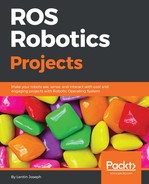ROS Robotics Projects is a practical guide to learning ROS by making interesting projects using it. The book assumes that you have some knowledge of ROS. However, if you do not have any experience with ROS, you can still learn from this book. The first chapter is dedicated to absolute beginners. ROS is widely used in robotics companies, universities, and robot research labs for designing and programming robots. If you would like to work in the robotics software domain or if you want to have a career as a robotics software engineer, this book is perfect for you.
The basic aim of this book is to teach ROS through interactive projects. The projects that we are discussing here can also be reused in your academic or industrial projects. This book handles a wide variety of new technology that can be interfaced with ROS. For example, you will see how to build a self-driving car prototype, how to build a deep-learning application using ROS, and how to build a VR application in ROS. These are only a few highlighted topics; in addition, you will find some 15 projects and applications using ROS and its libraries.
You can work with any project after meeting its prerequisites. Most of the projects can be completed without many dependencies. We are using popular and available hardware components to build most of the projects. So this will help us create almost all of these projects without much difficulty.
The book starts by discussing the basics of ROS and its variety of applications. This chapter will definitely be a starting point for absolute beginners. After this chapter, we will explore a wide variety of ROS projects.
Let’s learn and make cool projects with ROS!
Chapter 1, Getting Started with ROS Robotics Application Development, is for absolute beginners to ROS. No need to worry if you don’t have experience in ROS; this chapter will help you get an idea of the ROS software framework and its concepts.
Chapter 2, Face Detection and Tracking Using ROS, OpenCV and Dynamixel Servos, takes you through a cool project that you can make with ROS and the OpenCV library. This project basically creates a face tracker application in which your face will be tracked in such a way that the camera will always point to your face. We will use intelligent servos such as Dynamixel to rotate the robot on its axis.
Chapter 3, Building a Siri-Like Chatbot in ROS, is for those of you who want to make your robot interactive and intelligent without much hassle. This project creates a chatterbot in ROS that you can communicate with using text or speech. This project will be useful if you're going to create social or service robots.
Chapter 4, Controlling Embedded Boards Using ROS, helps you build a robot using Arduino, an embedded compatible board, Raspberry Pi, or Odroid and an interface to ROS. In this chapter, you will see a wide variety of embedded boards and interfacing projects made with them.
Chapter 5, Teleoperate a Robot Using Hand Gestures, will teach you how to build a gesture-control device using Arduino and IMU. The gestures are translated into motion commands by ROS nodes.
Chapter 6, Object Detection and Recognition, has interesting project for detecting objects. You will learn both 2D and 3D object recognition using powerful ROS packages.
Chapter 7, Deep Learning Using ROS and TensorFlow, is a project made using a trending technology in robotics. Using the TensorFlow library and ROS, we can implement interesting deep-learning applications. You can implement image recognition using deep learning, and an application using SVM can be found in this chapter.
Chapter 8, ROS on MATLAB and Android, is intended for building robot applications using ROS, MATLAB, and Android.
Chapter 9, Building an Autonomous Mobile Robot, is about creating an autonomous mobile robot with the help of ROS. You can see how to use packages such as navigation, gmapping, and AMCL to make a mobile robot autonomous.
Chapter 10, Creating a Self-driving Car Using ROS, is one of the more interesting projects in this book. In this chapter, we will build a simulation of self-driving car using ROS and Gazebo.
Chapter 11, Teleoperating Robot Using VR Headset and Leap Motion, shows you how to control a robot's actions using a VR headset and Leap Motion sensor. You can play around with virtual reality, a trending technology these days.
Chapter 12, Controlling Your Robots over the Web, we will see how to build interactive web applications using rosbridge in ROS.
